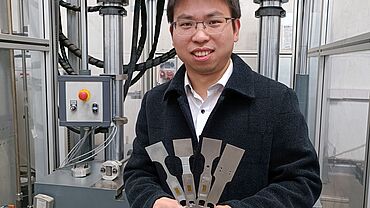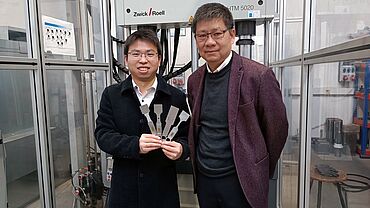ZwickRoell Science Award
For more than ten years, the ZwickRoell Science Award has honored current, outstanding science projects that make a valuable contribution to broadening the understanding of materials testing in various scientific disciplines. Through interaction and discussions with scientists we are continuously gaining valuable insights into where research progress is currently being made within the field of materials and components testing. Even we are continuously surprised to find new ways in which materials testing machines are being used. These insights help us to provide better solutions for our customers.
Science Award 2024 submission 2023 Science Award winner 2022 Award Winner Photo galleryFAQs
ZwickRoell Science Award 2024:
Have you published interesting scientific research in the area of materials testing? ZwickRoell awards this distinction to authors of scientific papers on the most innovative uses of materials testing machines. Submission deadline is March 9th, 2025.
Prizes
- 1st place: Paul Roell Medal and €5,000
- Second place: € 2,000
- Third place: € 1,000
You can find more information on the ZwickRoell Science Award in our flyer. We look forward to your submissions!
Frequently asked questions about the ZwickRoell Science Award
The first author of a scientific paper (regardless of whether he or she is still working at a university or a research institute). You are either currently working on your doctoral thesis or you received your doctorate no more than 10 years ago.
You can submit one peer reviewed accepted paper published in an international scientific journal.
You are allowed to submit supplementary documents which support your submitted paper.
The journal paper and a short CV about yourself.
No, every brand of materials testing machines can be used in the scientific work.
The publication year of the paper shall be 2023, 2024 or 2025.
A panel of judges (ZwickRoell experts committee and 3 internationally acknowledged professors) will
nominate the winners.
First place ZwickRoell Science Award 2023
Quality Improvement in Automotive Engineering: What is the Material Behavior of Sheet Metal in the Event of a Crash Load?
1st place of the ZwickRoell Science Award for the development of a testing methodology to determine more precise characteristic values in crash simulation
First place of the ZwickRoell Science Award (prize: 5,000 euros) this year goes to Chongyang Zeng from the University of Siegen. He developed a method for measuring the material behavior of sheet metal at high load speeds, as can occur in the event of a crash load. This measurement method ensures accurate results at high speeds without the interference of vibrations. The automotive industry benefits from the results in the development of increasingly high-quality materials. This year's award ceremony will take place in Ulm-Einsingen as part of testXpo 2024, our International Expo for Materials Testing (October 21-24).
Chongyang Zeng from the University of Siegen impressed the judges this year and took first place (5,000 euros) in the international ZwickRoell Science Award. By developing new geometric shapes for material specimens and using a measurement and evaluation method that eliminates interfering vibrations, more precise force measurements can be carried out—even at load speeds of up to 10 m/s and strain rates of up to 1000 s-1 on special servohydraulic testing machines for high-speed tests. This enables a more precise determination of the material behavior of sheet metal required as input for crash simulations in automotive engineering. The publication that won the ZwickRoell Science Award 2023 “Specimen Geometry Design for Plasticity and Fracture Characterization of Sheet Metal Under High Testing Speed and Various Stress States” was published in Thin-Walled Structures 186 (2023).



Universities and research institutes are important customers and partners for ZwickRoell, for whom we develop customized solutions. Every year, the award ceremony brings together the fields of science and industry and promotes an exciting exchange of ideas. This is one of the reasons why it always creates a special atmosphere and helps us to develop new, practical solutions in collaboration with our customers.
Christine Dübler, Board Member for Sales and Service at ZwickRoell
Researchers from 35 countries participate
This year's winners will present their projects in the form of short presentations during testXpo (October 21-24) on the ZwickRoell company campus in Ulm-Einsingen, Germany. More than 160 scientists from 35 countries submitted their work from various areas of materials testing this year. The research prize sponsored by testing machine manufacturer ZwickRoell recognizes - now for the 15th time - outstanding scientific work that makes a valuable contribution to expanding the understanding of mechanical testing in various scientific disciplines.
The other 2023 award winners
- Second place (2,000 euros): Dr. Akshat Agha from FADI-AMT LLC, USA for his publication “A Method for Measuring In-Plane Forming Limit Curves Using 2D Digital Image Correlation” in the SAE International Journal of Material Manufacturing Volume 16, Issue 3 (2023).
- Third place (1,000 euros): Dr. Carolina Furtado of the University of Porto in Portugal for her publication “Combined Bearing/Pull-Through Failure Envelope of Composite Joints: Experimental Setup and Numerical Validation“ in Composites: Part A Volume 175 (2023)
Winner of the 2022 Science Award
The ZwickRoell Science Award was presented during Academia Day at the Møller Institute at the renowned Cambridge University (United Kingdom). This year, a total of 212 researchers and scientists submitted their papers on topics from different areas in materials testing. The winners gave short presentations on their innovative testing concepts.
- First place (5,000 euros) went to Dr. Diego Misseroni from the University of Trento (Italy) for his publication in Extreme Mechanics Letters, entitled “Experimental Realization of Tunable Poisson's Ratio in Deployable Origami Metamaterials.”
- Second place (2,000 euros) went to Dr. Sergio Medina Escobar from the University of Girona (Spain) for his publication “Guided Double Cantilever Beam Test Method for Intermediate and High Loading Rates in Composites”, in the International Journal of Solids and Structures.
- And third place (1,000 euros) was awarded to Peter Hetz from the University of Erlangen-Nürnberg for his contribution published in CIRP Annals - Manufacturing Technology 71, entitled “Characterization of Sheet Metal Components by Using an Upsetting Test with Miniaturized Cylindrical Specimen.”


